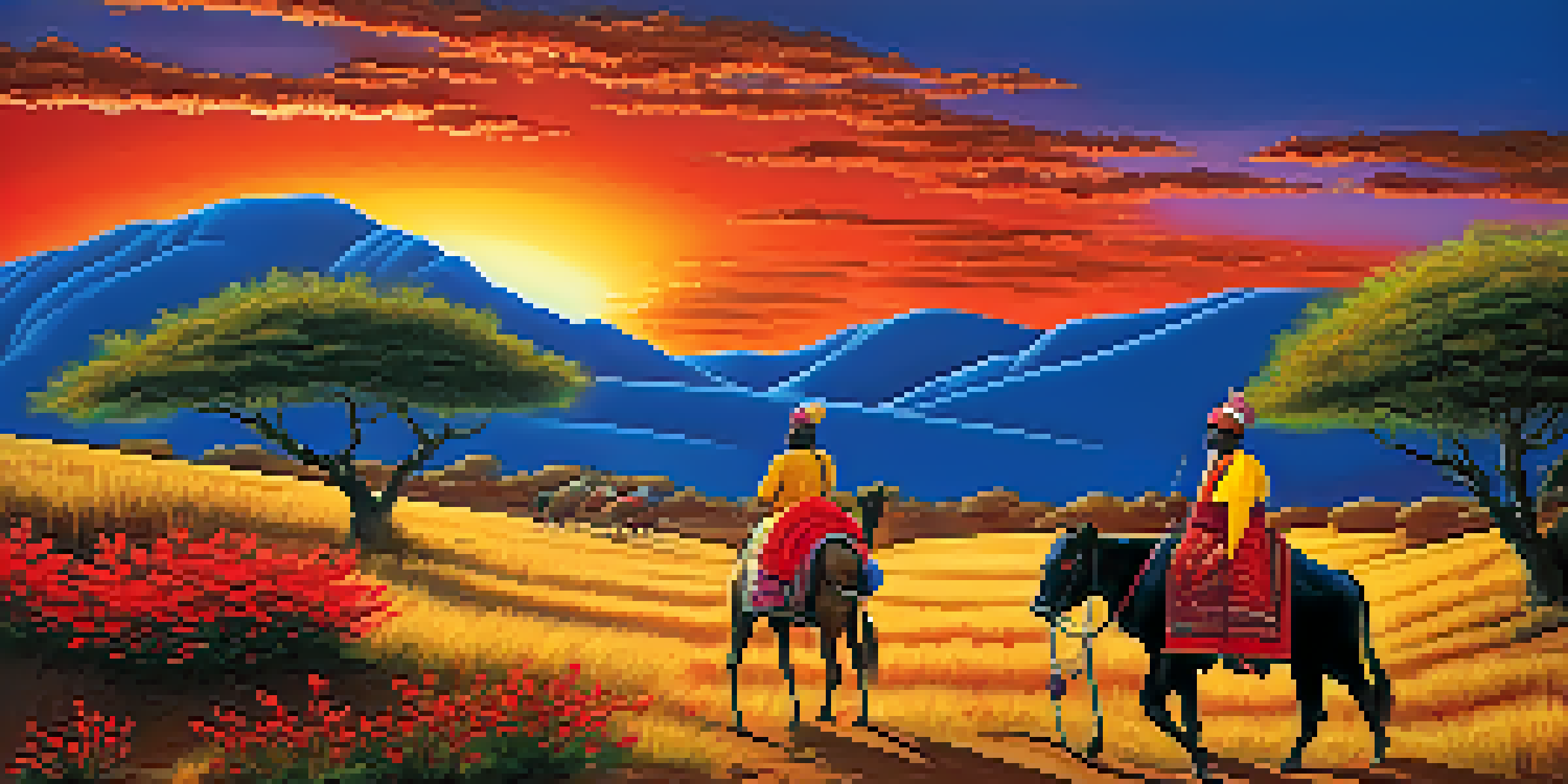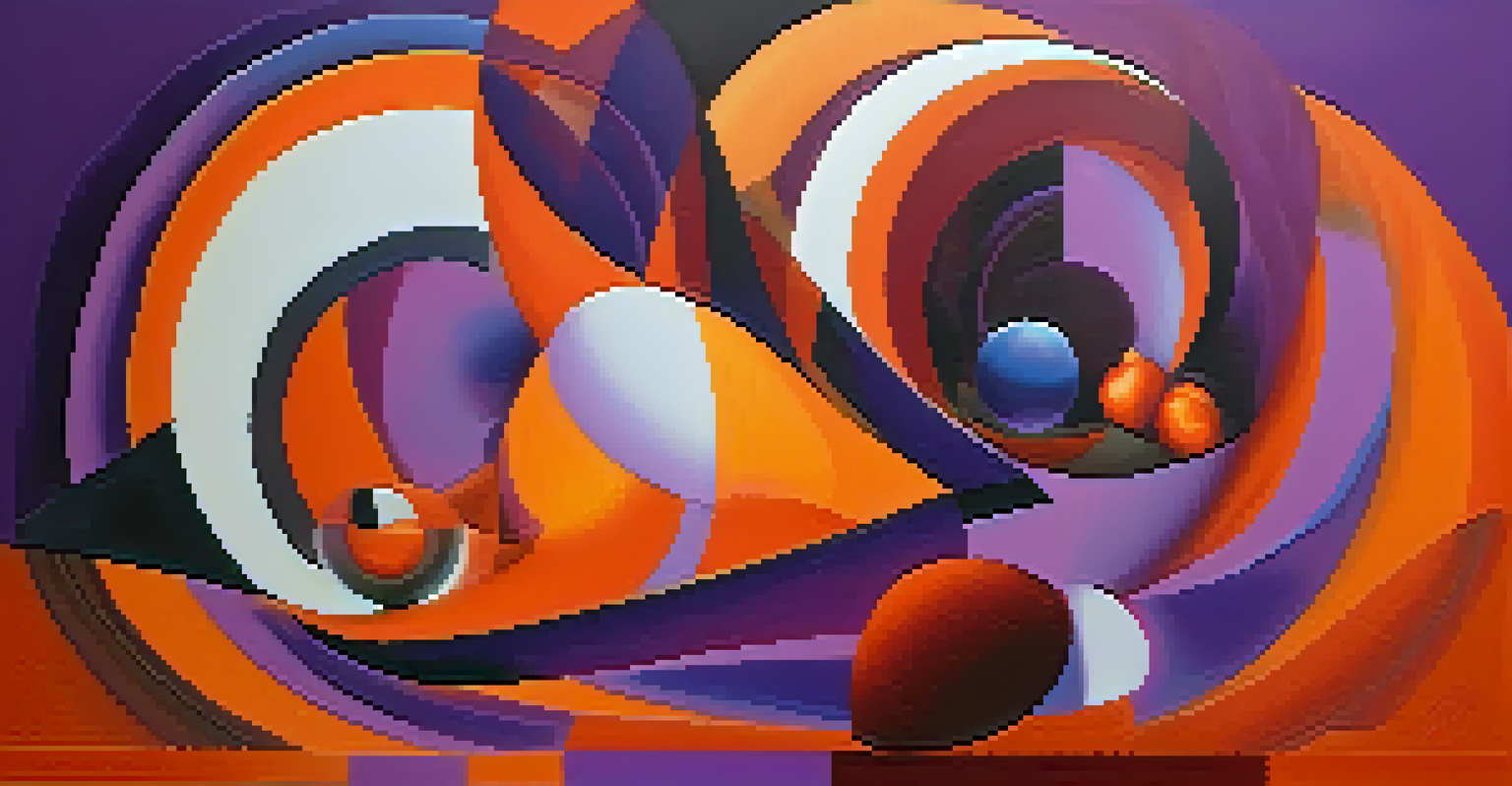The Importance of Color in Indian Traditional Paintings

Understanding the Cultural Heritage of Indian Colors
Indian traditional paintings are steeped in rich cultural heritage, where colors are not just aesthetic choices but carry significant meanings. Each hue is rooted in ancient traditions and beliefs, reflecting the values and emotions of the society. For instance, red often symbolizes love and passion, while yellow signifies knowledge and learning. This cultural context is vital for appreciating the depth of Indian art.
Color is the keyboard, the eyes are the harmonies, the soul is the piano with many strings.
When artists select colors, they often draw from historical texts and folklore, ensuring that their work resonates with the audience on a deeper level. This connection to history not only preserves cultural narratives but also enriches the viewer's experience. As such, the use of color becomes a storytelling medium that transcends time.
Moreover, these colors are often derived from natural sources, such as minerals and plants, emphasizing a harmonious relationship with nature. This eco-conscious approach adds another layer of significance to the art, making it an embodiment of sustainability and respect for the environment.
Symbolism of Colors in Indian Traditional Art
Color symbolism is a pivotal aspect of Indian traditional paintings, with each color having its unique representation. For example, blue often signifies divinity and tranquility, frequently seen in depictions of gods like Krishna. This use of color not only enhances the spiritual aspect of the artwork but also invites the viewer to engage with the divine.

Green, another prevalent color, embodies fertility and prosperity, often appearing in scenes of nature and rural life. By utilizing these colors, artists communicate messages of hope and growth, making their work relatable to everyday experiences. It’s fascinating how these symbolic meanings can evoke such strong emotional responses.
Colors Reflect Cultural Significance
In Indian traditional art, colors embody deep cultural meanings, representing emotions and values that enhance the viewer's connection to the artwork.
Additionally, the interplay of colors can create a narrative within the artwork itself. For instance, contrasting vibrant colors with muted tones can highlight specific elements, guiding the viewer's eye and shaping their interpretation of the scene.
Regional Variations in Color Usage
India’s diverse cultural landscape results in varied color palettes across different regions. For instance, the vibrant colors of Rajasthani paintings are often bold and bright, reflecting the arid landscapes and rich traditions of the area. In contrast, the subtler tones of Pattachitra from Odisha showcase the mythology and spirituality of the region, offering a more serene visual experience.
Art is the most beautiful of all lies; it is a truth that has been colored by the imagination.
These regional differences not only highlight local customs and environments but also provide insight into the unique artistic styles that have evolved over time. Artists incorporate local materials, which influence the colors they choose, contributing to the distinctiveness of each region's artwork.
Understanding these regional variations allows art enthusiasts to appreciate the rich tapestry of Indian traditional paintings. It showcases how geography, culture, and local resources intertwine to create unique artistic expressions.
The Role of Color in Storytelling
In Indian traditional paintings, color plays a crucial role in storytelling, often guiding the viewer through the narrative embedded in the artwork. Each color can indicate mood, time of day, or even the emotional state of characters depicted. For example, a bright yellow might suggest joy and celebration, while darker tones could denote sorrow or conflict.
Much like a director uses lighting and color in film, artists utilize color to evoke specific feelings and reactions from the audience. This intentional use of color enriches the storytelling aspect, making each piece a multi-dimensional experience.
Regional Variations in Color Use
The diverse colors used in Indian paintings vary by region, showcasing unique artistic styles shaped by local customs and natural resources.
As viewers, we are invited to interpret the story through our personal lenses, influenced by our own experiences and emotions. This subjective interpretation adds depth to the artwork, creating a dialogue between the viewer and the artist.
Color Techniques in Traditional Painting Methods
The techniques used to create colors in Indian traditional paintings are as rich as the meanings behind them. Artists often employ methods passed down through generations, using natural pigments derived from minerals, plants, and other organic materials. This not only ensures vibrant colors but also aligns with the sustainable practices that honor the environment.
These pigments are mixed with binders such as gum or milk, allowing artists to achieve a range of textures and finishes. The meticulous process of preparing these colors can take days, reflecting the dedication and skill of the artist. This craftsmanship is a testament to the value placed on quality and authenticity in traditional Indian art.
Incorporating these techniques into their work allows artists to maintain a direct connection to their heritage, creating a living tradition that resonates with both old and new generations. This blend of tradition and innovation continues to inspire and attract art lovers worldwide.
Modern Interpretations of Traditional Color Usage
As Indian traditional art evolves, contemporary artists are reinterpreting the use of color in innovative ways. They often blend traditional palettes with modern techniques and themes, resulting in unique pieces that resonate with today's audience. This fusion not only preserves the essence of traditional art but also makes it accessible to a broader demographic.
For instance, artists might use vibrant colors to address modern social issues, creating a bridge between the past and present. This approach invites viewers to reflect on contemporary life while appreciating the historical context of the colors used.
Color as a Storytelling Tool
Colors in Indian art serve as powerful storytelling elements, guiding viewers through narratives and evoking specific emotions.
Moreover, as globalization increases exposure to various art forms, Indian artists are experimenting with colors influenced by international styles. This cross-pollination of ideas fosters creativity and helps redefine what traditional art can be in the modern world.
The Emotional Connection of Colors in Art
Colors evoke emotions, and in Indian traditional paintings, this connection is particularly powerful. When we look at a piece filled with bright reds and yellows, we may feel a sense of warmth and happiness, while cooler hues like blues and greens can evoke calmness and reflection. This emotional resonance is one of the key reasons why art has such a profound impact on viewers.
Artists are acutely aware of this connection and often use it to guide the viewer's emotional journey through their work. By thoughtfully selecting colors, they can elicit specific feelings, creating a shared experience between the artwork and its audience.

Ultimately, the emotional connection fostered by colors in Indian traditional paintings highlights the power of art as a medium for expression and communication. It reminds us that art is not just about visuals; it's about feeling and connection, transcending cultural and geographical boundaries.